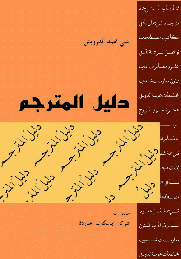|
Book Review The Translator's Guide
Reviewed by
Darwish writes in the opening lines of his book that his work is a practical guide for students and practising translators, providing a practical framework and a clear methodology for translation, so the reader can be clear about what to expect from the book. In chapter one, the author discusses language and its function. Stressing the importance of translation as communication, in chapter two he outlines the process of monolingual and bilingual communication. Writing is at the heart of any translation endeavour. An effective translator is essentially an effective writer, the author confirms. Consequently, chapters three and four are dedicated to the fundamentals of writing, and since translation is about transfer of meaning, in chapter five, Darwish discusses meaning, its types and levels, asserting the notion that the ultimate goal of translation is to preserve the meaning of the original in its totality Ė notwithstanding the constraints and restrictions the limits of translatability impose on the process. For teachers of Arabic translation, the task of preparing students to become professional translators is foiled by the lack of a clear teaching methodology and serious textbooks about the subject. For students, the situation is even worse. Arabic translation books are not available and students often have to struggle with abstruse English language sources. Chapter seven constitutes the centerpiece of the book. Aptly titled Translation Dynamics, the chapter discusses translation techniques, approaches and the constraints that drive the process of translation. In this chapter, a great deal of energy is dedicated to providing practical solutions to translation problems specific to Arabic. In chapter eight, translation problems are discussed in three areas of the translation process: comprehension, processing and production. Long neglected in translation books and on translation courses, terminology and the centrality of the translatorís role in Arabic terminology occupy a space in the book. Terminology and word formation techniques are explained in chapter nine, while transliteration and transcription are discussed in chapter ten. Chapter eleven provides a comprehensive set of practical steps for translation. In chapter twelve, Darwish discusses interpreting types, prerequisites and situations. Throughout the book, Darwish returns to the assertion that translation is a process of approximation and that optimal approximation is driven mainly by the purpose of translation task. He makes a distinction between legitimate intervention and illegitimate interference stressing the importance of preserving the information integrity of the original text in terms of its information content and informative and communicative intentions. In chapter thirteen, Darwish discusses body language and its importance in interpreting. In chapter fourteen, he covers machine translation while in chapter fifteen, Translation Matrices, he provides ready-made translation examples of proverbs, idiomatic expressions and United Nations phrases. The professional integrity of translators and interpreters has been a hot issue in Australia recently. In chapter sixteen, the author outlines the code of ethics of the profession. The three appendices provide a set of passages for translation, linking devices in English and Arabic and a glossary of translation terms. The book provides a framework for teaching the subject of translation in a structured and practical fashion. If you have been looking for an Arabic textbook on translation, your search is over. The Translatorís Guide is just such a textbook. © 2001 Jeanette Hourani, Melbourne.
Home | Abstracts | Books | Glossaries | Interviews | Contact | Legal Notice |
 Not only is this book an academic textbook, but also the author, Ali Darwish,
devotes a great deal of effort to provide practical examples through contrastive
analysis of Arabic and English passages on the semantic, pragmatic and
rhetorical levels.
Not only is this book an academic textbook, but also the author, Ali Darwish,
devotes a great deal of effort to provide practical examples through contrastive
analysis of Arabic and English passages on the semantic, pragmatic and
rhetorical levels.